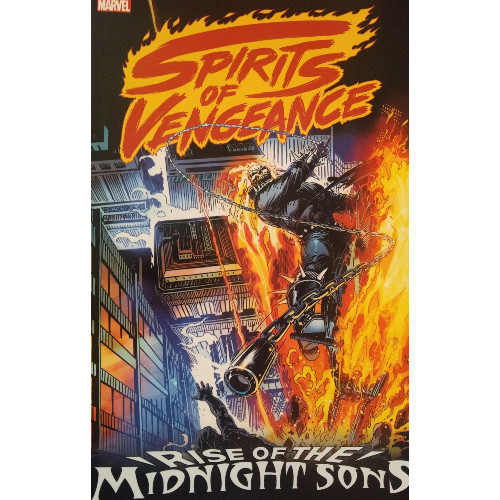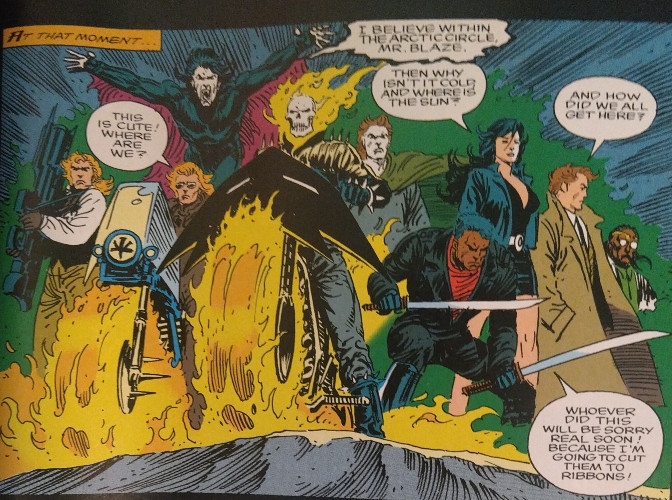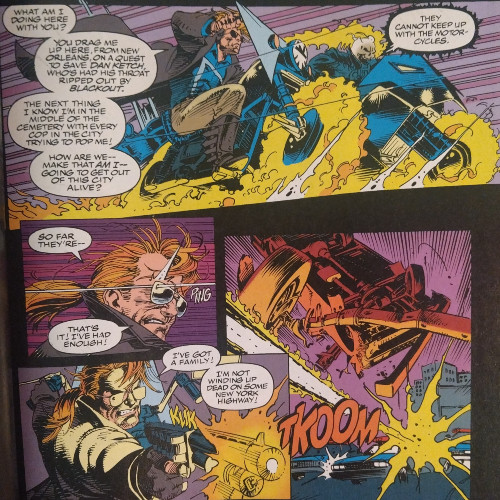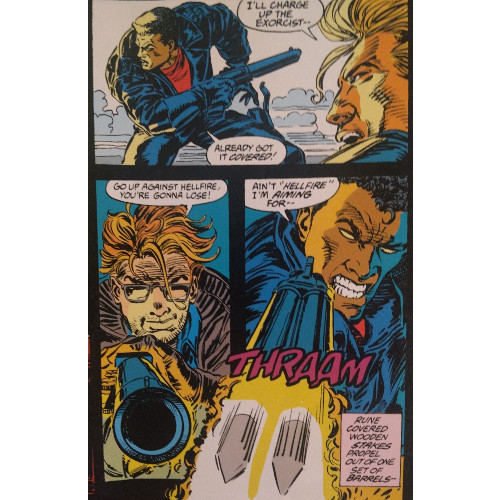(Strand)om Stories: Spirits of Vengeance: Rise of the Midnight Sons Review
The sons may rise, but the day dwindles quickly on a volume filled to excess with cheesy 90s tropes
—by Nathan on August 29, 2024—

I have not played the (relatively) recently released Midnight Suns game by Marvel. To be honest, I probably won't touch it. I've never been much of a fan of turn-based RPG video games, and though Midnight Suns has been well-received critically, the style just has not caught my attention.
So, with your permission, we can settle for a review of the game's source material.
This was, originally, intended to be a "Spider-view" review. I was under the impression that, though the "Rise of the Midnight Sons" (and that's "Sons" with an "o," not a "u") arc incorporated various members of Marvel's mystical character roster, Spidey would play a significant role in the overarching narrative. Spotting a decently priced volume at a Half-Price Books, I flipped through the pages and, lo and behold, there was the wonderful Web-Head swinging across the pages. What I failed to deduce was the reason why I spied those pages so near the end of the volume…Spidey only appeared in a second story tacked onto the primary "Midnight Sons" narrative included in this collection. Undaunted by the update, I decided to chop the volume in two: this "(Strand)om Stories" review will cover the "Midnight Sons" portion, while a "Spider-view" post will tackle the secondary "Spirits of Venom" arc shortly thereafter. It's a nice surprise, actually. Two blogs for the price of one.
And speaking of prices, we're diving into the depths of vengeance for this narrative, harnessing the spirit of revenge which not only drives the flame-headed Ghost Rider but also a powerful vampire queen bent on world domination.
Spirit of Vengeance: Rise of the Midnight Sons
Writers: Howard Mackie, Len Kaminski, Christian Cooper, and D.G. Chichester
Pencilers: Andy Kubert, Adam Kubert, Ron Wagner, Richard Case, Ron Garney, Alex Saviuk, and Klaus Janson
Inkers: Joe Kubert, Adam Kubert, Mike Witherby, Chris Warner, Mark McKenna, Tom Palmer, Josef Robinstein, Bill Reinhold, Klaus Janson, Arthur Adams, Tom Mandrake, and Dan Panosian
Colorists: Gregory Wright, Glynis Oliver, Tom Palmer, Bob Sharen, and Renee Witterstaetter
Letterers: Janice Chiang, Michael Heisler, Phil Felix, John Costanza, Dave Sharpe, Steve Dutro
Issues Collected: Ghost Rider #28 and #31, Ghost Rider/Blaze: Spirits of Vengeance #1-6, Morbius: The Living Vampire #1, Darkhold: Pages from the Book of Sins #1, Nightstalkers #1, Web of Spider-Man #95-96, and material from Midnight Sons Unlimited #1
Volume Publication Date: May 2022 (latest printing)
Issue Publication Dates: August 1992-January 1993, April 1993

I'm writing this review purely in preparation for another review, but because of other obligations, it's been some time since I finished the Midnight Sons volume. I apologize for my possibly shaky memory and how that may influence what I write today. No, I am not being compelled to say this under the influence of otherworldly forces. I am merely possessed by a poor memory.
Rise of the Midnight Sons is predicated on gathering up a whole buncha dudes from the mystical side of the Marvel Universe and throwing them together in what feels like a logical combination. You got your skull-headed biker Ghost Rider, your vampire slayer Blade, your actual vampire Morbius, even a little finger-wagging magician like Doctor Strange, all pitted against demonic denizens under the thrall of the evil Lilith, the self-proclaimed Mother of Demons. The grouping makes sense–each of these guys belong in the same ethereal, eldritch corner of the Marvel sandbox, dealing with magical threats, demons, monsters in general. They're all anti-heroes, with the exception of Strange, but even he shapes events in the background to suit his purposes. Dressed in black and using fangs, knives, chains, and guns, these protagonists embody much the same excessively 90s spirit (no pun intended) you'd find from Image's stable of anti-heroes.
Maybe that's why things start going wonky pretty soon after the story starts.

I won't deny that Marvel doesn't have an impressive roster of grim-faced warriors. For every quip-cracking Spider-Man and fervently patriotic Captain America, there's a vengeance-driven Punisher or shadow-stalking Wolverine. But these characters in particular–Ghost Rider, Blade, Morbius–through the way they're dressed and handled, makes me feel as if Marvel is really trying to push an agenda to become as much like Image as possible. Liefeld and Co.'s characters hadn't been around for very long–Youngblood debuted in April 1992, Spawn in May–but their instant financial success appears to have inspired Marvel to go in a similar direction. The aura generated by Spawn, himself resurrected as part of a deal made with a demon, lays heavily on the narrative. Our heroes are weighed down by the weapons they wear, hellfire burns in the hands of their adversaries, and demons of all shapes and shades skitter and crawl across the pages. It's even indicated demons enjoy metal music, so you know we're in deep "extreme" territory. Can't get much darker than a demon headbanging to satanic devil music! BLEGH!
What damages the narrative even further is that so much of the story seems geared to kicking off different series; I assume Marvel hoped this "event" would be such a success that spin-offs would be inevitable: we get the first issues of Morbius, Nightstalkers, and Darkhold, which admittedly ran for somewhat longer than I would have originally anticipated. Morbius had a three-year run, while Nightstalkers and Darkhold lasted for two. I don't know sales figures for each of these series, but it's telling that no less than three brand new series debut as integral chapters in this overarching narrative, simply to give their primary protagonists some additional publicity and turn this mystical side of Marvel into a franchise like their best-selling X-books.

Merit exists in the core of each character or group featured here. At the time, Ghost Rider had been separated from original host Johnny Blaze and attached to Danny Ketch, who was temporarily deceased when this story was published, leaving Blaze to team with the untethered Spirit of Vengeance Zarathos. Writer Howard Mackie endeavors to develop an intriguing internal struggle for Blaze, who had abandoned superheroing when separated from Zarathos and settled down with a family. Blaze is pictured as torn between his family and rejoining a world of monsters and mayhem for the express purpose of keeping them safe.
Elsewhere, Dr. Michael Morbius is offered his constant struggle between satiating his (literal) bloodthirsty urges and resisting his bloodlust for the safety of his fellow man. We don't get much of this, just that one debut issue; to my knowledge, the 90s Morbius series has never been collected, so I don't know how writers like Len Kaminski painted his struggles. It's an interesting notion, but in this volume, the idea is truncated by the presence of so many other concepts and characters. Nightstalkers seeks to revitalize characters from Marvel's 1970s Tomb of Dracula series, such as Blade, Frank Drake, and Hannibal King. They're dragged from obscurity and updated for the era, which generally means that instead of using garlic and holy crosses to fight demons, they use high-tech weaponry crossed (again, no pun intended) with magic…though Blade still turns to old-fashioned wooden stakes, even if he fires them from a double-barreled shotgun. But though there's an attempt to pull some seemingly forgotten folks from the darkness to fight the shadows, not enough is done to warrant much interest. Maybe I expect too much out of inaugural issues.

But I do believe the problems I find with this volume point to a deeper trend sweeping across the industry, which I often spoke of in my "Image Review-lution" series. It's that ever-encroaching love of darkness and violence, replacing definitive character moments with big explosions, high-tech weaponry, guys carrying a whole lotta knives and guns, and really ugly demons for the sake of peppering your pages with really ugly demons. From a design aspect, it hits that "cool" factor. A double-barreled shotgun that fires wooden stakes? Awesome! And something like that fits the vibe of the vampire-slayin', demon-fightin' characters we follow. But adorn our heroes with big ol laser guns and our villains with spikes, bone-spurs and other bodily blades a certain Superman-slayer would adopt a few months later? That just feels cheesy and unimaginative.
It's a sense of "pretense" over "purpose," like so many other comics from the 90s. Marvel gets so lost in the look and feel of these characters, they ignore giving them intentional motivations outside "Let's kill some demons." Pieces exist, for sure–Blaze grapples with the impact his actions will have on his family, and writer D.G. Chichester tries to draw Drake and King into the "present day" through dope armaments. Steps are taken, but they're small and feel hollow.

Plot-wise, we're moved quickly through battle after battle between various heroes and some demonic threats. New, one-use villains pop up frequently with names like "Steel Vengeance" and "Meatmarket," quickly posing a threat and just as quickly cut down (and I highlight the names to jokingly point to how ridiculous they sound, though I'll admit if guys named "Ghost Rider" and "Blade" first popped up in the 90s, I'd be equally as acerbic). And even though the story wraps up in a big ole brouhaha between the baddies and not-so-baddies, closure is denied by an epilogue, the conclusion of which is consistent with the "revolving door" nature of comics but confounding for anyone hopeful for a satisfying resolution.
Those "Spirits of Venom" issues, as I noted, are inserted after the "Rise" narrative, so while they belong to the volume, I'll save those for a later post. We thus end the volume not quite as empty-handed as we entered but grasping very little. Moments pop up here and there which indicate fraught internal tension for some of our characters as they stare steely-gazed into the heart of a Demon Mother's world-altering scheme. But those pieces feel haphazardly inserted, perhaps explored in issues not contained in this volume. Would I appreciate Morbius or Nightstalkers more if I gave further issues a read? It's possible, but I still feel they'd have a snowball's chance.